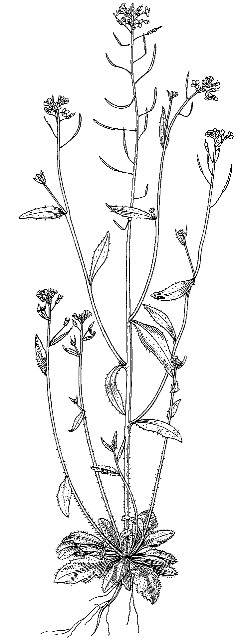
Botany for the Next Millennium:
Plants create a green backdrop for our lives, at once subtle and essential. We mark time and the change of seasons with them, adorn our public and private spaces with them. We cultivate them, for food and clothing and building material, and for their sensory appeal. We depend on them utterly, as the first link in the food chain we are part of and the source of the oxygen we breathe.
The study of plants was originally inspired by our needs and practical interests. The word botany has in its heritage the Greek verb boskein, to feed, as well as the name for plant, botane. Yet throughout history this practical-based science has yielded great insight into our understanding of all life.
Gregor Mendel, raised on a farm in a region of orchards and vineyards, formulated the rules of heredity through his experiments with pea plants. Charles Darwin, trained as a
 |
|---|
| Arabidopsis thaliana, the diminutive weed that has become the object of investigation of hundreds of plant biologists worldwide. Redrawn from: Stella Ross-Craig. 1949. Drawings of British Plants, Part III Cruciferae. G. Bell and Sons Ltd., London. |
Most recently, studies of the main plant enzyme involved in photosynthesis turned up a class of universal proteins now known as molecular chaperones, which have reworked understanding of the way proteins are assembled.
The best questions have not been exhausted (Appendix A). Our understanding of life and its bulk constituent, the plants,1 is still far from complete. Today a few plants such as maize, tomato, and, notably, Arabidopsis, a fast-growing, easy-to-manipulate weed, are enlightening larger questions in genetics and development. Yet the plant world contains many more systems and phenomena awaiting a Mendel or a McClintock. Plant studies in particular are poised to make the needed connections between sequences of DNA, their effects on the organism, and the organism's ecological role-a crucial integration often lacking in biology today. This report, in its first part, situates the importance of plant studies within three major areas of biological inquiry:
In each area, plants offer a wealth of compelling material and systems that have been underexplored or unintegrated with the main questions in biology, largely because of biologists' narrow training. Knowledge of plant diversity, plants as organisms, and plants as the dominant biotic feature of our environment are central to our understanding of the world and our relations with it.
Nor have our practical or applied interests in plants diminished. They are at the center of the two salient environmental issues of our time, global climate change and the loss of biological diversity. The second part of the report examines the status of our knowledge in exploiting the full potential of plants for our sustenance--for food, fiber, feed, fuel, and pharmaceuticals-in the context of these global issues.
Finally, the third part of the report details what botanists, individually and collectively, must do to maintain the distinguished record of achievement and discovery in botany. Integration of research is key, along with more attention to education and communication. The specific recommendations grow out of a detailed, first-of-its-kind survey of the membership of the Botanical Society of America and 10 cooperating societies (Appendix A). The collective voice that emerged was surprising, given that almost half the surveys were returned; the high response rate indicates the health of the profession as well as concern about the state of botany at the end of the 20th century. As the Society enters its second century, the survey offers an historically valuable accounting of how botanists view their work.
1Historically, all organisms were divided into either the plant or animal kingdom. By this tradition, botany included, as it does today, the study of algae, lichens, and fungi, as well as plants (bryophytes and vascular plants).




